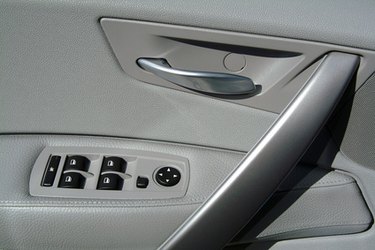Things You'll Need
Dish soap
Coarse sponge
Rags
Towels
180-grit sandpaper
Professional painter's tape
Masking paper
Heavy-duty fabric drop cloth
Flexible vinyl spray paint

If you plan to paint the inside panel of your car door, consider some important points before you dive into the application process. Interior car door panels are composed of pliable vinyl or plastic. These surfaces are not suited for paint adhesion and will reject new finishes unless they are properly conditioned. In addition, ordinary acrylic and latex paints are not suited for flexible vinyl and will eventually crack and peel. You must choose a special paint with strong elasticity and bonding capabilities.
Step 1
Lower the window and open the car door.
Video of the Day
Step 2
Clean the car door panel with soap, using a sponge. Rinse the panel with wet rags and dry it with a towel.
Step 3
Abrade hard vinyl or plastic interior car door panels to promote adhesion. Scour the panel until it feels slightly rough. Do not abrade soft vinyl surfaces.
Step 4
Use painter's tape and masking paper to cover areas of the door panel you do not want painted. Place a drop cloth beneath the open door.
Step 5
Coat the interior car door panel with two coats of flexible vinyl spray paint. Maintain an 8-inch distance between the panel and the spray nozzle as you apply. Wait two hours between coats.
Step 6
Remove the tape and masking paper while the flexible vinyl paint is still wet. Wait four hours before touching the door.
Warning
Don't paint an unabraded car door panel, or the finish might chip and peel.
Don't use ordinary acrylic or latex paint on a hard vinyl or plastic car door panel, or the finish might not remain durable.
Video of the Day